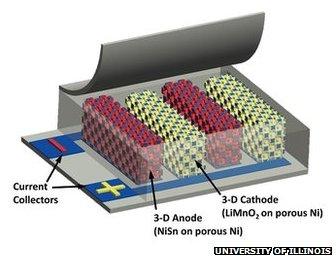Super-powered battery breakthrough claimed by US team
- Published

A new type of battery has been developed that, its creators say, could revolutionise the way we power consumer electronics and vehicles.
The University of Illinois team says its use of 3D-electrodes allows it to build "microbatteries" that are many times smaller than commercially available options, or the same size and many times more powerful.
It adds they can be recharged 1,000 times faster than competing tech.
However, safety issues still remain.
Details of the research are published in the journal Nature Communications.
Battery breakthrough
The researchers said their innovation should help address the issue that while smartphones and other gadgets have benefited from miniaturised electronics, battery advances have failed to keep pace.
Batteries work by having two components - called electrodes - where chemical reactions occur.
In simple terms, the anode is the electrode which releases electrons as a result of a process called oxidation when the battery is being used as a power source.
The cathode is the electrode on the other side of the battery to which the electrons want to flow and be absorbed - but a third element, the electrolyte, blocks them from travelling directly.
When the battery is plugged into a device the electrons can flow through its circuits making the journey from one electrode to the other.
Meanwhile ions - electrically charged particles involved in the anode's oxidation process - do travel through the electrolyte. When they reach the cathode they react with the electrons that travelled via the other route.
The scientists' "breakthrough" involved finding a new way to integrate the anode and cathode at the microscale.
"The battery electrodes have small intertwined fingers that reach into each other," project leader Prof William King told the BBC.
"That does a couple of things. It allows us to make the battery have a very high surface area even though the overall battery volume is extremely small.
"And it gets the two halves of the battery very close together so the ions and electrons do not have far to flow.
"Because we've reduced the flowing distance of the ions and electrons we can get the energy out much faster."
Repeatable technique
The battery cells were fabricated by adapting a process developed by another team at the university which is designed to make it faster to recharge the batteries than lithium ion (Li-on) and nickel metal hydride (NiMH) equivalents.
It involves creating a lattice made out of tiny polystyrene spheres and then filling the space in and around the structure with metal.
The spheres are then dissolved to leave a 3D-metal scaffold onto which a nickel-tin alloy is added to form the anode, and a mineral called manganese oxyhydroxide to form the cathode.
Finally the glass surface onto which the apparatus was attached was immersed into a liquid heated to 300C (572F).
"Today we're making small numbers of these things in a boutique fabrication process, but while that's reliable and we can repeat it we need to be able to make large numbers of these things over large areas," said Prof King.
"But in principle our technology is scalable all the way up to electronics and vehicles.
"You could replace your car battery with one of our batteries and it would be 10 times smaller, or 10 times more powerful. With that in mind you could jumpstart a car with the battery in your cell phone."
Safety fear
Other battery experts welcomed the team's efforts but said it could prove hard to bring the technology to market.
"The challenge is to make a microbattery array that is robust enough and that does not have a single short circuit in the whole array via a process that can be scaled up cheaply," said Prof Clare Grey from the University of Cambridge's chemistry department.
University of Oxford's Prof Peter Edwards - an expert in inorganic chemistry and energy - also expressed doubts.
"This is a very exciting development which demonstrates that high power densities are achievable by such innovations," he said.
"The challenges are: scaling this up to manufacturing levels; developing a simpler fabrication route; and addressing safety issues.
"I'd want to know if these microbatteries would be more prone to the self-combustion issues that plagued lithium-cobalt oxide batteries which we've seen become an issue of concern with Boeing's Dreamliner jets."
Prof King acknowledged that safety was an issue due to the fact the current electrolyte was a combustible liquid.
He said that in the test equipment only a microscopic amount of the liquid was used, making the risk of an explosion negligible - but if it were scaled up to large sizes the danger could become "significant".
However, he added that he soon planned to switch to a safer polymer-based electrolyte to address the issue.
Prof King added that he hoped to have the technology ready to be trialled as a power source for electronic equipment before the end of the year.
The University of Illinois at Urbana-Champaign team is one of several groups attempting to overhaul the way we power gadgets.
Researchers in Texas are working on a kind of battery that can be spray-painted onto any surface while engineers at the University of Bedfordshire are exploring the idea of using radio waves as an energy source.
- Published8 March 2013
- Published29 June 2012
- Published10 September 2011
- Published11 February 2012